Next day of Onam – Grandmas preserved leftover of Onam feast this way, long before refrigerators came into rural areas
When pumpkin plant flowers, it gives the first signal of Onam – Say old people. Yellow flowers will open their star eyes in the midst of green round leaves and Onam will come as guest soon. There was a time when days starting with Thiruvonam star of Karkidakam to Thiruvonam star of Chingam month, approximately 28 days carried shades of Onam, a time when preparation of Onam celebration starts. Of these 28 days, last 10 days starting with Attam star were celebrated in a wide way, a practice followed still now.
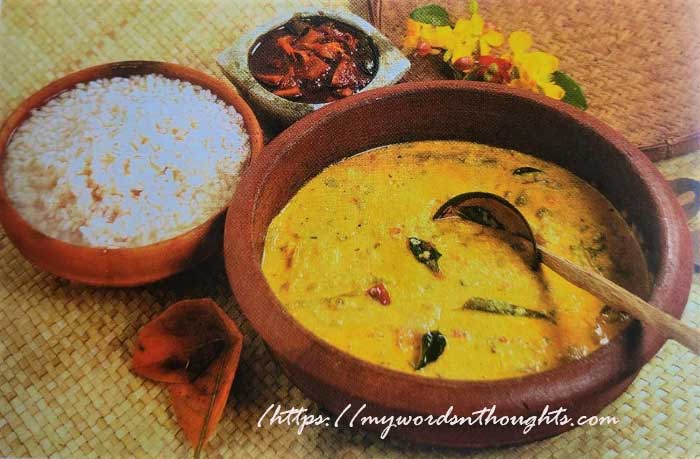
Just a pookkalam or new dress doesn’t complete Onam. Onam celebrations complete only with Thiruvona Sadya or grant feast consisting of numerous curries, side dishes and desserts. Now Onasadya can be ordered online from home. But decades back, all children used to come back to their ancestral homes, where they jointly made the feast, long before mixer grinders and gas stoves came into existence. From drying spices to grinding them in stone, from cutting vegetables to cooking in wooden hearths, a lot of efforts were required, and all those efforts were for a single day Thiruvona Sadya. Dishes tasted wonderful as they were ground manually and prepared using wooden hearths. After Sadya, kins used to chew pan, swing and dance, play some interesting Onam games and dance to Kaikottikali and Thumbi Thullal, before celebration ends.
Those days, most famous were not rich. Things were totally different. In most homes, they get the best food and dress on Onam day, and forgetting all sorrows and miseries, they celebrated, just as the saying goes, Kaanam Vittum Onam Unnanam. After a magical Onam season, days of poverty and struggles waited most homes, and life goes on. Housewives were smart and experts those days, who know the tricks to make delicious dishes from the leftover of the previous days. Most homes were deprived of refrigerators, and they had their own ways to preserve the leftover for the next day. Kondattam made from leftover cooked rice holds a unique taste. Even Kanji (Porridge) made by adding water overnight in the leftover rice tastes different with sambar and rasam of the previous day.
“Onnam Onam Odiyum Chaadiyum, Randaam Onam Irunnum Ninnum, Moonnaam Onam Mukkiyum Mooliyum, Naalaam Onam Nakkiyum Perukkiyum, Anjaam Onam Anjiyum Kunjiyum, Aaraam Onam Arinjum Thirinjum, Ezhaam Onam Erannum Karanjum……” This Onam song tells the struggles of families, after an Onam celebration, and how they eat from first Onam to seventh Onam. It’s about those glorious yesterdays, where people work hard throughout a year, and eat and celebrate a single day on Onam.
Day after Thiruvonam
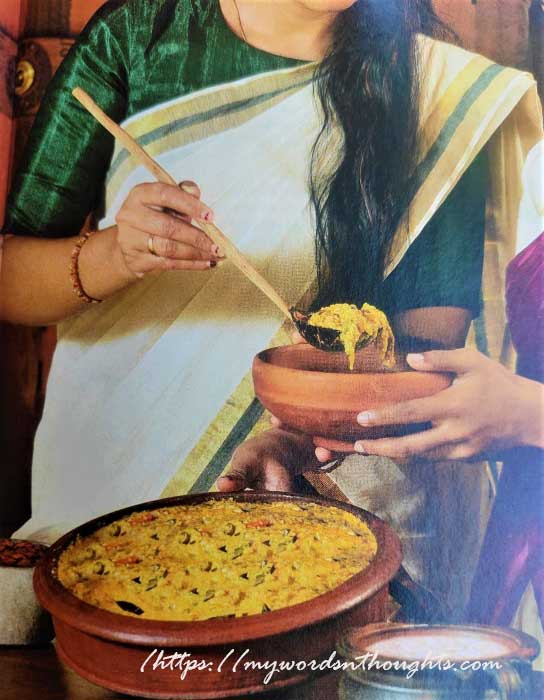
There is one interesting Onam tale about a Namboothiri, most Malayalis are familiar with. The story goes like this. After having Onasadya, a Namboothiri was facing discomfort as he ate too much. Seeing this, his Karyasthan (assistant) said, “If you are feeling this much problem, why can’t you put two fingers inside your mouth and vomit a little bit? You will feel better.” But Namboothiri replied, “If there is space for a single finger, I would have drunken one more glass of Payasam”.
Though it’s a humour tale, it was the social condition prevailed in Kerala decades back. It’s a single day of whole year, where a family make so many dishes together – Kalan, Olan, Erisseri, Upperi, Pazhanurukk (Banana boiled), Pachadi, Kichadi, Sambar, Rasam, Pappadam, Paripp, Pradhaman etc. Those days rice freshly brought from fields were used for Sadya. Along with it, making all these vegetable dishes and desserts, made it a big feast. After having all these tasty dishes together, and ending with a glass of payasam, it’s only possible to take rest in bed or courtyard. That’s why it’s said, ‘Thirinjum Marinjum’, because of extra food taken. It’s a far cry from today’s Onam, where Onam celebrations are conducted in every corner where Malayalis exist, and different menus previously prepared to celebrate each day of Onam.
During our old rural days, when agriculture was the main source of income, people worked hard under direct sun whole day, sowing seeds and harvesting, and mostly have Kanji (porridge) as meals. For the same reason people didn’t throw away even the leftover rice starch of Onam rice. They will pour that rice starch to the leftover rice and take it as breakfast (Pazhamkanji). Pickles and leftover curries made their breakfast grand.
Curries may not be left over that much. In those days each home had 7-8 children, and the leftover items often lead to fight among kids. Curries which change colour soon and can get damaged easily are Paripp, Sambar, Thoran, Erisseri etc. Even if prepared at noon, they may change taste and adour after sunset. But curries like Kalan and Pulissery can stay fresh for long time. Even during those days without refrigerators, people knew some magical tricks to preserve curries and side dishes.
Soon after dinner of Thiruvonam night, people start preparations for it. In old days, many homes prepared 28 dishes. Except pickles and payasam, they put all leftover dishes together in an earthen pot or stone pot and mix well. Except curd, the items may include Dal (paripp), Sambar, Olan, Avial, Thoran, Koottucurry, Thottucurry of different types etc. As Rasam and Pulissery have more water content, they avoid these dishes.
Next day, this fermented dish is boiled well and used as ‘Pazhakoottaan’ by people of South Kerala, which is used as breakfast. It’s served along with Pazham Kanji (Porridge) prepared from leftover rice and starch water. Along with it, pickles like Vadukapuli (big lemon) will be served. This pickle turns softer and tastier as days pass by.
Dishes prepared in Onattukara and the surrounding places are bit different from normal Kerala sadya. In the Pazhakoottaan prepared for the next day, they add Kaalan also, which comes under Kurukk (thick) Pulissery type. They also add leftover rice to their pot. Next day the whole contents will turn thick, and when it’s heated, it turns thicker. As it’s served on Avittam day, it’s also called Avitta Katta (literally Avittam lumps). An old proverb says, ‘Thick Avitta Katta should be broken using stamping by feet’ (Avittakatta Chavitti Pottikkanam), or does it mean, If you eat Avitta Katta you will get energy to kick and break anything?
Next day of Onam (Avittam), after breakfast, kitchen also takes rest for a while. It’s a day after Onam’s tedious sadya preparation, and most people prefer to give all works a break. In the song (written in Malayalam) which depicted different Onams, Second Onam is ‘Kandonam’. Here, Thiruvonam day is taken as first Onam, it seems. All the leftover curries of Thiruvonam used for next day (Kandonam) without preparing new dishes, and that day should be calculated like this. Maybe it’s depicted in that poem.
Onam season of Vadukapuli too
It’s during Onam season, Vadukapuli (big sized lemon) fully ripens, and it’s available in market everywhere. It has thick outer skin, which has to be showed in direct flame first, thus burning stain and then only used for preparation. Then it is cut into 1-centimeter square pieces, after removing seeds and thread. These pieces are put in earthen pot or Bharani. Crystal salt is boiled well adding water, and then dust particles are removed before adding to lime.
Red chillies are first washed and then dried under direct sun, fried in a pot greased with coconut oil, powdered and used in this pickle. Juice squeezed from well ripen vadukapuli is taken in an earthen pot, added turmeric and salt, and boiled in low flame. When it turns thick, it’s also added to the vadukapuli pieces. After having excess Payasam during sadya, you can have a single bit of this pickle, to get over the sweet taste of tongue and it also refreshes the stomach after a heavy meal.
Each region has its own taste
As told earlier, like each sadya carries distinct trades of region and have slight difference from one another, Pazhankanji Koottaan also differ slightly from place to place. In Thiruvananthapuram, Avial, Thoran, Paripp and Sambar are used for the preparation of Pazhankanji. Though Avittakatta and Kaadi (made from leftover starch) have literally faded from Kerala kitchens, those who have tasted it at least once in their lifetime will definitely never it in their lifetime.
There is one proverb, “Kaadi aayalum moodi kudiykkanam”, which literally translates, ‘Even if it’s leftover rice starch water, you should drink secretly’. In real meaning, it expresses the smartness of Malayalis to hide their problems/poverty etc from others and how they solve it.
The impressive ‘Rasa Kaalan’
In Thrissur region, there is a small type sadya prepared on 4th Onam. It’s the same day, when Thrikkakkara Appan and Maadevar are removed from flower offerings (Attam) placed in courtyard. Same day, poovada is offered and big sized banana (Nentrapazham/Ethapazham) is boiled, and served. Read more about such interesting customs related to Poovada and Onam.
In Thrissur, if Palada is prepared on Thiruvonam day, Banana pradhaman is prepared on fourth day. One of the main reasons behind is, in Thrissur there is a popular culture to display Nentrapazham bunch on Thiruvonam day (Second Onam) and also to give as gift to families. On fourth day, banana will be well-ripen with dark skin and hence pradhaman is prepared using it, apart from poovada and boiled bananas. Normally people don’t prefer over-ripen banana to eat, but it tastes best for pradhaman, and hence this sweet dessert is prepared in homes. When it’s fried in a little ghee, it adds extra taste to pradhaman.
Along with it, different vegetable side dishes and curries will also be prepared. On Thiruvonam day, there will be many vegetables left after preparation, and on Avittom day, curries of Thiruvonam will be used. In those days when refrigerators were not common in Kerala household, not to waste such vegetables, dishes will be prepared from them on fourth Onam. Avial made from different vegetables is a must. Rasakalan, made using ripen banana is another special dish prepared on this day. Yes, people of yesterdays knew the magic to make unique dishes from leftover dishes as well as vegetables, days when wastage of food was minimal.
The sweetness of Kerala banana
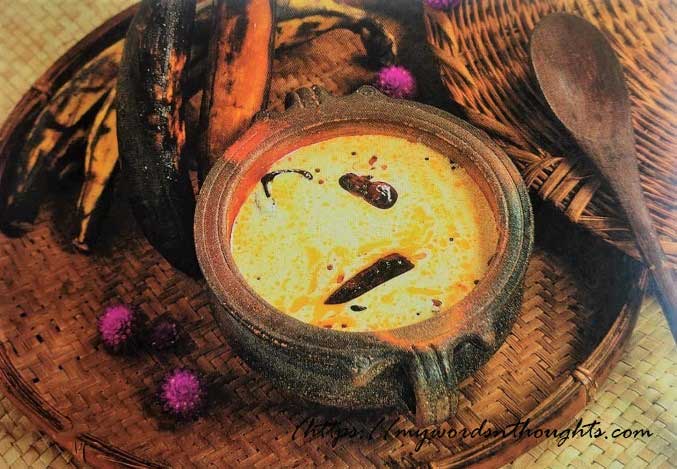
Big sized banana, known as nentrapazham and ezhapazham forms an integral part of Onam culture. In many regions, especially mid-Kerala, this banana is boiled every day during Onam days. During old days, even the water leftover after cooking banana was not thrown away. This water is strained, a piece of boiled banana is smashed and added. Then add a few more ingredients like ginger, green chillies, salt and turmeric and boil it well. Your instant and delicious banana curry is ready! In short, those days, even the water used for boiling banana was not wasted.
The remaining vegetables like eggplant, yam, colacasia, banana etc are fried and kondattams prepared. In Thrikkakara temple, Unakkalari (a type of rice) is used to decorate the main idol. Later this rice is powdered and smashed bananas are added to it, and deep fried in oil to prepare banana bonda (pazha bonda). It’s also a special snack during Onam season. But remember, this snack belonged to privileged class in the society those days. There also existed a class of poor people, who didn’t get many of these things during Onam season.
After ‘Kodiyonam’, it’s ‘Kaadiyonam’
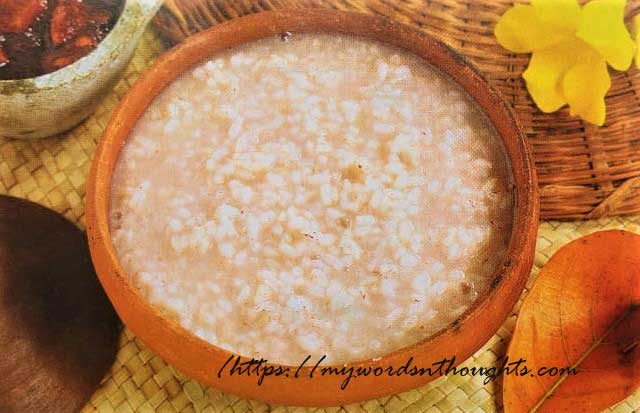
“Moonnaam Onam Mukkiyum Mooliyum” – As the Onam song goes. Leftover of curd added pulissery and some pickles or side dishes – when such dishes form a part of Moonam Onam (Third day of Thiruvonam), displeasure maybe shown on face. Naalaam Onam Nakkiyum Perukkiyum – Fourth Onam was more pathetic, when leftover dishes are almost finished. Water used to wash rice one day ago is used to cook brown raw rice (not parboiled rice) the next day. This porridge (Congee) is called Kaadi. The leftovers of curries and side dishes stick to the bottom of pots are used along with Kaadi. In short, only the memories of sweet dishes stay in tongues, and the rest have gone.
On 5th Onam, people associated with farming would have entered fields to resume their work. People may cook rice or congee at home, while male members working in fields, and non-vegetarian dishes like fish will enter the menu. In some places, Kaadi was served on 6th Onam. That’s why it’s said, ‘Anjonam Konchonam, pinne kaadi Onam’.
‘Kaadi’ of Kaadionam has a distinct flavour. On the thick rice starch of Thiruvonam day, curries are mixed, and the Kaadi prepared on 4th Onam is poured into it. On Chathayam star day, it’s strained and water used to wash rice (kaadi) that day is added to it. On the 6th day, again it’s strained and Champa Pachari (brown raw rice) is added to it, cooked and porridge is prepared. If you manage to adjust with its unpleasant odour, Kaadi is a delicious dish. Why not? Always old things have an intense, unique and pungent smell.
Many banana bunches are chopped off during Onam season to prepare boiled banana, banana chips, sharkkara upperi and also delicious side dishes like raw banana mezhukkupuratti, erisseri, kaalan, banana skin podithooval, pindi curry (made using banana stem) etc. Many dishes form a part of menu in the next days of Onam.
To prepare dishes from banana stem (vaazha pindi) is not so easy. First, they are cut into round pieces, removed the fiber and chopped fine. Again, using a coconut leaf midrib, the fiber content is removed maximum, and later cooked by adding turmeric, salt and sufficient water. Temper onion and red chillies in coconut oil, cooked banana stem is added followed by scrapped coconut. It’s cooked for a while till water content is fully absorbed, and taken off from flame. There is a saying about banana stem, which literally translates as, if banana stem reaches stomach, it will search and find its siblings. Here siblings means, waste which got stuck in stomach and intestine. Banana stem helps to fully flush out the toxic contents of stomach, thus purifying the digestion track.
Poocha Kanji and Onayunda
In some parts of North Kerala, there is a dish called Poocha Kanji, which literally translates as ‘Cat Congee’. Keep Kaadi water for two days, and on third day, broken rice (Nurungari), rice bran (thavid) and jaggery are added to this Kaadi water. This Poocha Kanji is prepared on Pooradam star, just before Thiruvonam.
Onayunda (Onam balls) are prepared on the next day of Thiruvonam. Put scrapped coconut, jaggery, cardamom and cumin into a stone grinder (ural) and make a fine powder. Then it’s transferred to a sieve and made big balls. It’s rolled on fried rice flour and made balls again. They are wrapped in white dhotis and hung somewhere, and allowed to dry. As it dries more, it tastes better. During old days, peasants used to give onayunda as gift to landlords and owners of their farms. In return, they are rewarded with rice, dhoti and money.
‘Vaavu vannu vaathil thurannu, nira vannu thiram kootti, puthari vannu pathari vachu, Onam vannu kshenam kootti’…… ‘Onamunda vayare, choolam paadi kida….’, here goes some less-heard Onam songs which still hold reminiscences from past, still waiting for those majestic days to return.
Also read some unique articles related to Onam celebrations and old days. Click on the images in the gallery to read.




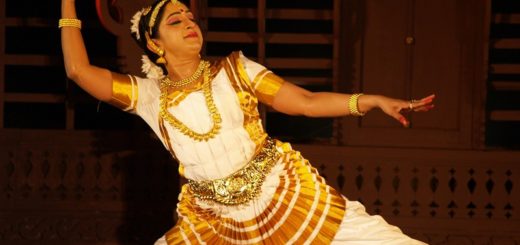









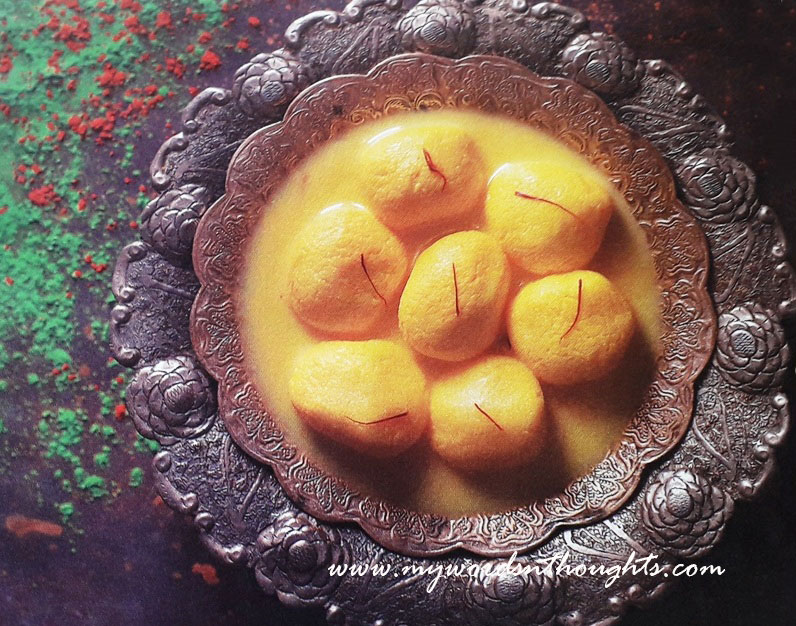
Recent Comments